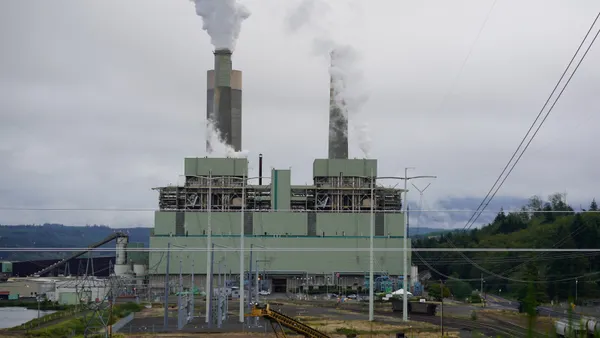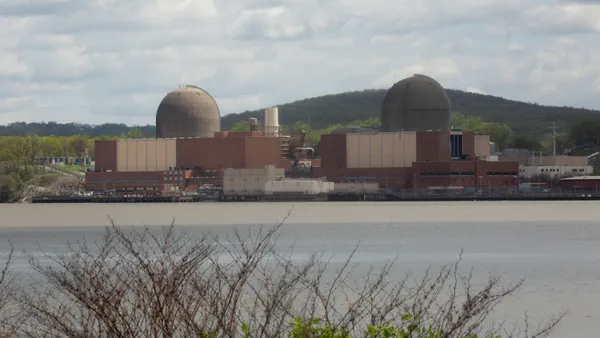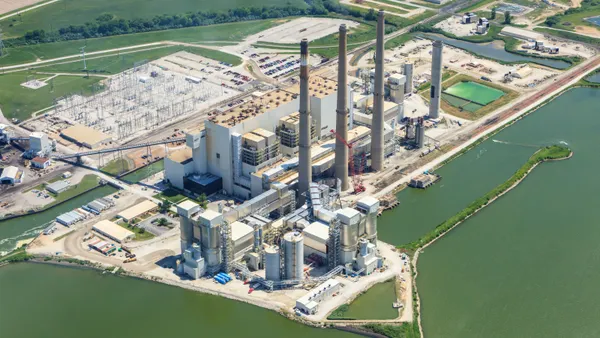Dive Brief:
-
CenterPoint Energy subsidiary Vectren Energy on Monday announced it would retire 730 MW of coal by 2023, leaving its resource mix at 12% coal-fired power by 2025.
-
The utility's current generation portfolio is 78% coal. Vectren's preferred integrated resource plan, based on an all-resource request for proposals, would add 700 MW to 1,000 MW of solar+storage, 300 MW of wind, 30 MW of demand response resources and 460 MW of combustion turbine natural gas plants. In total, the mix would be 64% renewable energy plus demand response by 2025.
-
Vectren said its proposed plan is expected to reduce greenhouse gas emissions 75% below 2005 levels by 2035, and save customers up to $320 million over the next 20 years. The utility has been under pressure from some legislators in recent years to keep Indiana coal online, but consumer advocates in the state say they're pleased the company followed economic signals, rather than political ones.
Dive Insight:
The falling costs of wind, solar and natural gas resources have pushed utilities across the country to diversify their resource portfolios and take advantage of the favorable economics. But that shift has been more polarizing in states like Indiana where the coal industry makes up a significant portion of its workforce.
"It takes a little bit of courage on the part of Vectren to really rebuke what's been going on at the Statehouse," Kerwin Olson, executive director of Citizens Action Coalition (CAC) of Indiana, told Utility Dive. "They were already under significant pressure, to say the least."
Vectren in 2018 revealed a plan that would have shuttered three coal-fired plants and replace them with a large combined cycle natural gas plant, as well as some solar. In response to that plan as well as a scenario filed by the Northern Indiana Public Service Company (NIPSCO) later that year that would eliminate all coal from its fuel mix by 2028, state lawmakers proposed legislation that would place a moratorium on new resources in the state in a bid to protect coal-fired power from getting replaced.
Though the bill failed in the 2019 legislative session, lawmakers earlier this year managed to pass highly-contested legislation, House Bill 1414, that makes coal plants in the state more difficult to retire.
But despite the legislature's efforts to slow the transition from coal, Vectren's resource mix is taking a dramatic shift in the next five years with its fossil fuel-installed capacity expected to drop from 90% to 36%, while renewables and demand response rise from 10% to 64%.
"House Bill 1414 appears to be a colossal waste of everybody's time, and really underscores how the Indiana legislature is really out of touch with not only where the markets and technology are, but also where the utilities are," said Olson. "So [I'm] thrilled to see Vectren sort of rebuke the political pressure, if you will, to keep coal plants running."
Others noted the utility's move, alongside NIPSCO's, might spur other utilities in the state to move away from coal as well.
"Seems to me that Duke, Indianapolis Power & Light and [Indiana Michigan Power] are now under even more pressure to retire coal plants and make bigger investments in clean energy now that both NIPSCO and Vectren have announced plans for a major energy transition this decade," Principal Energy Policy Analyst at EQ Research Ben Inskeep said in a Tweet.
But one point of contention with clean energy and consumer advocates in the state is Vectren's continued investment in natural gas as well as its plan to keep Unit 3 of its Culley coal plant open into the 2040s.
Vectren's plan is in part a response to last year's partial rejection of its $900 million IRP. State regulators ruled that at $800 million the proposed gas plant was too expensive and could lead to stranded asset costs, but approved the utility's plan to retrofit its largest and "most efficient" 270 MW Culley coal-fired unit with emissions reduction technology at a cost of $95 million.
In response, Vectren elected to keep the unit in its mix, while adding more renewables, demand response and efficiency. It also developed a plan to instead build out smaller, more flexible combustion turbine gas units that it plans to bring online by 2024, allowing it to retire its coal more quickly and offset market risk, according to the utility's stakeholder meeting slides, where it announced its plan.
The units are "designed to back up the renewable resources that supply the majority of customers' energy needs," Vectren said in a statement.
The utility is filing its full IRP with regulators June 30. Overall, Vectren pointed to the advantages of moving its portfolio away from coal and toward more economic options.
"Avoiding future coal maintenance investments will ensure local generation has a responsible renewable-to-carbon balance while ensuring the reliability our customers expect," Lynnae Wilson, chief business officer at Indiana Electric Utility Business for CenterPoint, said in a statement. "We are incredibly sensitive to customer impact, and with stakeholder input, we feel this planning process has produced a cost-effective plan that moves us toward a future built on cleaner generation."
Olson said CAC and others in the state will likely challenge the continued operation of Culley 3 in particular.
"We certainly will not relax our criticism of the continued use of coal and the continued operations of Culley 3, which will become less and less economic as time goes by," he said.














